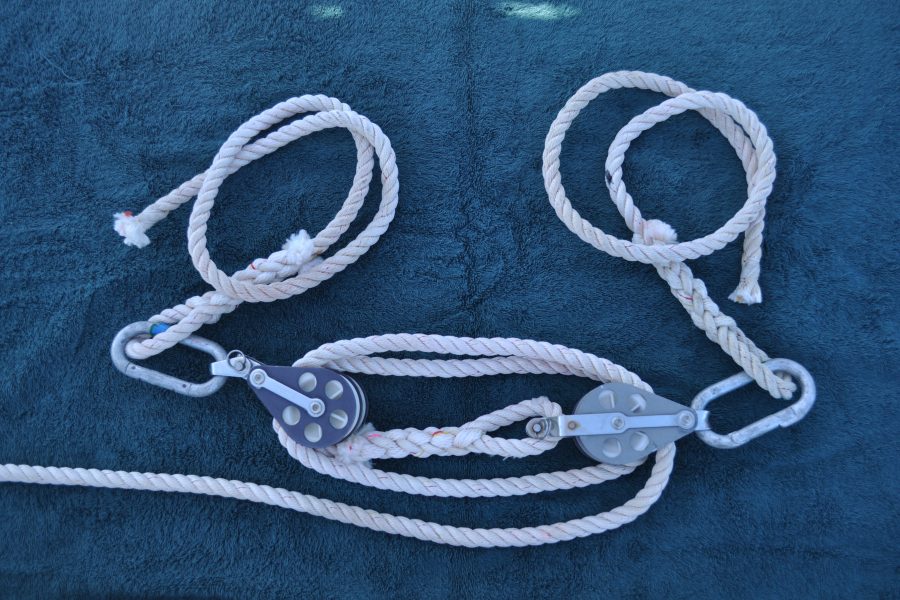
In the age winches to help us lift loads didn’t exist, Block and Tackles were used everywhere to reduce loads and man-power needs
Aboard any sailing vessel, the need frequently arises when a little assistance in holding, lifting or relieving a load would be greatly appreciated. Back in the day of “Wooden Boats and Iron men” a variety of blocks and tackles were rigged to aid with loads that today we typically get from winches and windlasses.
All the different types of block and tackle rigs had different names, usually representing where they were employed on board. One block and tackle rig built with two blocks, either two double blocks or a double and single block was known as a Handy Billy and still has many uses onboard today’s boats.

On the left a Handy Billy with 4:1 lifting power, on the right 3:1. On the bottom the parts of a block
Where might we use a Handy Billy? Have a winch with an override, need to lift a heavy load out of the dinghy, lift the dinghy motor up to the rail for storage or have a man or big dog overboard, need to haul someone up the mast a Handy Billy with a long line will save you a lot of work cranking on a winch. Have your anchor hung up, a Handy Billy attached to the anchor rode then lead to the windlass or a cockpit winch might just do the trick. If there is a load to be moved or a strain to be relieved a Handy Billy will do the job.
When building, or using a Handy Billy keep in mind its load limitations. Know the safe working load limits of all the components as your Handy Billy is only as strong as its weakest component. Hardware manufactures publish the safe working load of their blocks, shackles, and carabiners. Line manufactures, on the other hand, do not publish safe working loads but they do publish tensile strengths. According to the Cordage Institute, a line used as a lifeline such as in lifting a man requires a 15:1 safe working load. Thus, a new ½” 3 strand nylon line with a 7500lb tensile strength would have a theoretical safe working load of 500lbs when used to hoist a man. Note I said a new line if using an older line, you must consider its condition and any defects to determine a safe working load limit. That said it should go without saying anytime you are lifting someone up a mast in any fashion a safety line must be employed so the man aloft cannot be accidentally dropped.
When building, using and stowing a Handy Billy your biggest limitation will be the length of line needed. A Handy Billy built with a single and double block providing a 3:1 power ration will require 3’ of line for every foot of movement, a 4:1 power ratio using two double blocks will require 4’ of line for every foot of lift. So, a Handy Billy with a 10’ lifting range, sufficient for most boats to lift gear from the dinghy or a man out of the water over the lifelines, with a 4:1 ratio will require 50’ of line including the hauling part. This length of line is a manageable package to stow and use.
On the other hand, if you are building a Handy Billy to lift yourself up a 50’ mast with a 4:1 ratio you will need 250’ of line and will have a very inconvenient package to stow. Personally, I prefer any of several other methods available to get myself or someone else up a mast, a Handy Billy being just too inconvenient for the job. By inconvenient, I mean that when attempting to use a Handy Billy to ascend a mast on your own you need to have a way to stow and manage the hauling part as you ascend. Letting it all collect on deck means the hauling part is going to find something to wrap itself around thus stranding you somewhere up in the air on your way down. It is best if using a Handy Billy to ascend a mast that you have someone on deck to keep your hauling part running clear.
My preferred Handy Billy setup consists of two double blocks, one of which has a becket to which one end of the tackle is secured, two mountaineering carabiners each having a 36” strop eye spliced to them and 50’ of ½” 3 strand nylon. This setup meets the vast majority of my needs and makes a small package to stow when not in use.

A 4:1 Handy Billy with 3′ strops on each end. The Handy Billy can be attached to a halyard or fixed point with either the carabiner or the strop. Note the carabiners used are mountaineering carabiners that have a load rating the same as the other components

This photo shows a block with becket to which an eye has been spliced. The strap at the top of the block has a carabiner and 3′ strop attached
When I need to lift a load from the dink or out of the water I attach the upper block to the main halyard shackle using the carabiner on the upper block. I then adjust the height of the upper block by raising or lowering the main halyard.
When being used to relieve a load on a sheet so I can release an override on a winch I attach the upper block to the sheet 5’ or so away from the winch with a rolling hitch using the strop eye spliced to the carabiner then secure the lower block to a cleat, haul on the Handy Billy creating slack in the loaded sheet between the upper block and the winch. Relieve the override then using the winch retighten the sheet and remove the load from the Handy Billy.
To assist with a stuck anchor or to increase the power of your windlass, say when you are aground and wish to use your windlass to haul yourself off, attach the upper block of the Handy Billy to the anchor rode as far out as you can within the limit of your Handy Billy’s length (you will need to do this from the dinghy) and attach the lower block to a cleat at the bow. Use a snatch block to lead the hauling part of the tackle fair to the windlass gypsy to haul yourself off. Now your windlass with say, a maximum hauling capacity of 1000lbs, will with a 4:1 Handy Billy apply a maximum of 4000lb hauling capacity.
Again, especially when working with heavy loads such as retrieving a stuck anchor or hauling your boat off a mudbank, beware of your Handy Billy’s safe working load as well as that of any hardware you attach it to and beware of where you stand. You don’t want to be in line with anything that might break and snap in your direction with force!
Over the years, I have found dozens of uses for a Handy Billy, it has saved my back and shoulders, saved flogging sails when a sheet has developed an override and allowed me to lower very heavy objects safely into the dinghy that if I had attempted to lower by brute force might have fallen and gone through the bottom of the dink.
As its name implies a Handy Billy will frequently be a welcome and handy addition to your crew!







Leave a Reply
Your email is safe with us.